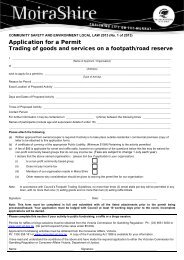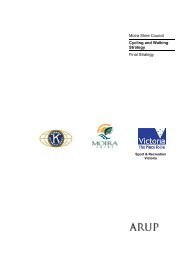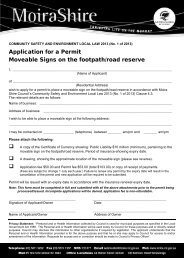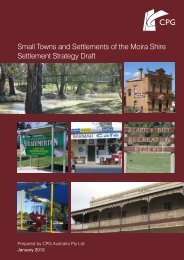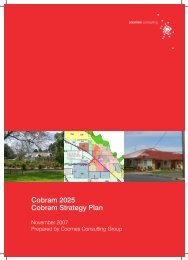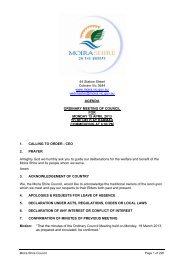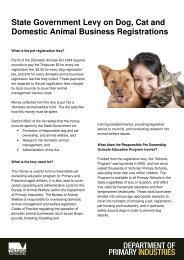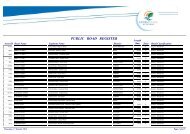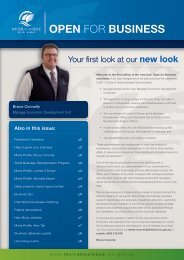Bundalong - Moira Shire Council
Bundalong - Moira Shire Council
Bundalong - Moira Shire Council
- No tags were found...
You also want an ePaper? Increase the reach of your titles
YUMPU automatically turns print PDFs into web optimized ePapers that Google loves.
3.1 Lake edge treatmentsThe type of edge treatment along the foreshore impactson the functionality of the area for different recreationalactivities, the visual character or experiential ‘setting’ ofthe space, the habitat value of the foreshore, and theability of the foreshore to withstand erosion.The nature of the edge treatment should be consistentwith the primary function of the space and thelandscape setting type These will be key aspects toconsider for design specifications.––Ensure the foreshore continues to supporta suite of spaces that vary in their functionand setting type, and selectively attractdifferent users from different catchmentsEnsure that incremental development is notallowed to impact on the quality of experiencesthat depend on the natural values of spaces. i.e.more conservation based functions should havemore forested settings with natural edge treatmentsand a relatively low level of facility provision––Trail options include; unformed access waysfor walking, unsealed paths suitable forwalking and cycling, elevated boardwalksmore suited to walking than cycling, andpaved shared paths for a variety of users.Explore hard engineering options for the lakeedge along the foreshore where appropriate,ie; where habitat significance is low, therisk of erosion is high, and for a lake sidepromenade within a suburban settingThe StrategyDemand Management Strategy––Establish a range of parkland settings tosupport a diversity of experiences along theforeshore, that consider demand and thatenable the assets to be maintained in anacceptable condition. Then designate thenature of user (catchment), function and settingtype for each reserve to manage demandThe range of settings would be basedon a number of factors, including:––––––Page 20The nature of the existing conditions and anunderstanding of the activities dependanton those conditions, including erosion.The degree of environmental sensitivitysurrounding the reserveThe functions, activities and settings ofneighbouring land along the foreshoreThe necessary water edge treatment tosupport the desired activities at the reserveThe proximity to residents and touristattractions, and the subsequentdesire for nature based experiencesor highly serviced destinationsThe likelihood of long or short visitsto the reserve (i.e. play for twentyminutes, or picnic for a day)–Provide selected areas suitable of sustaininghigh levels of use and that encourage socialinteraction and provision for visitorsCommunication Strategy–Provide an overview of the foreshore in signageand in brochure form that clearly articulate therange of spaces (including the function, landscapecharacteristics and nature of facilities they canexpect to find at the space) and areas suitable fordifferent types of activities, for visitors and residentsFacility Strategy––––Ensure the nature of facilities provided on theforeshore match the catchment of users, andthe function and setting types of the spacesProvide a hierarchy for each type of facility inkeeping with functions and setting typesFor example, boat launching: Provide welldesigned public boat launching facilities that canserve power boats. Low key community jetties,canoe steps, rowing landing stages and grassyembankments can support non powered boatlaunching in less social and select locationsA range of access ways / trails along the foreshorecan be provided in areas where formed pathwaysare not suitable (i.e. in front of residences frontingthe lake where the public land reserve is narrow).––––To the area of active erosion along River Road,substantial engineering works are requiredto address bank stability. Preliminary studieshave been initiated to provide informationabout the feasibility of such works. Thesecould be developed further to incorporate apedestrian promenade and to improve theaesthetic values of the current treatmentPhase out the use of rough rock for edgetreatments or for stabilising the embankment,and replace with other more suitabletreatments depending on the intended functionand setting type of that part of the foreshoreAlong the lake edge to the Woodlandsresidential area, a variety of small retainingwalls have been implemented by localresidents. It is recommended GoulburnMurray Water develop a standard lake edgespecification (for a small retaining wall) andthat this be licensed to adjacent privateland owners for construction and ongoingmaintenance. Opportunities also exist for softengineering treatments in this area such asgeo-textile matting and riparian vegetationUse soft edge treatments such as geo-textilematting and aquatic vegetation (grass, shrubs, waterreeds) in areas of moderate and high environmentalsignificance, where these values are to bemaintained and protected. This type of treatmentalso provides increased opportunity for habitatestablishment, particularly in the Bathumi area––Where the construction of a shared pathway alongthe foreshore reserve is not possible, an elevatedboardwalk in the lake is considered to be aninteresting alternative to provide public accessConsider the provision of a variety ofretaining walls in high use areas or grassedembankments in low profile areas whereshort term tie up options are availablePolicy and Planning Strategy–Pedestrian promenade and retaining wall exampleSoft engineering (geo-textile matting) exampleAdopt the guidelines identified in the FacilityStrategy, regarding edge treatments, into the overalldesign guidelines developed for the foreshore



